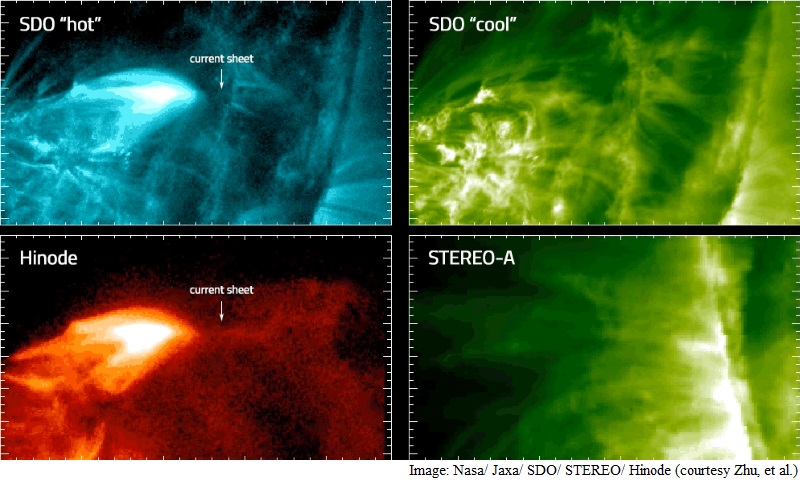- Home
- Science
- Science News
- Nasa Helps Decode Solar Flares With 'Current Sheet' Observations
Nasa Helps Decode Solar Flares With 'Current Sheet' Observations

A "current sheet" is a very fast and flat flow of electrically-charged material, defined in part by its extreme thinness compared to its length and width.
"Current sheets" form when two oppositely-aligned magnetic fields come in close contact, creating very high magnetic pressure.
The multi-faceted view of the December 2013 flare was made possible by three solar-watching missions: Nasa's Solar Dynamics Observatory (SDO), Nasa's Solar and Terrestrial Relations Observatory (STEREO) and Hinode, a collaboration between the space agencies of Japan, the US, Britain and Europe.
Solar flares are intense bursts of light from the sun. They are created when complicated magnetic fields suddenly and explosively rearrange themselves, converting magnetic energy into light.
"The existence of a 'current sheet' is crucial in all our models of solar flares," said James McAteer, astrophysicist at New Mexico State University.
"These observations make us much more comfortable that our models are good," he added.
The strongest solar flares can impact the Earth's atmosphere and interfere with our communications systems and also disrupt onboard satellite electronics.
Unlike other space weather events, solar flares travel at the speed of light, meaning we get no warning that they are coming.
Better models lead to better forecasting, said Michael Kirk, space scientist at Nasa's Goddard Space Flight Center in Greenbelt, Maryland.
"These complementary observations allowed unprecedented measurements of magnetic reconnection in three dimensions. This will help refine how we model and predict the evolution of solar flares," Kirk added.
Because "current sheets" are so closely associated with magnetic reconnection, observing a "current sheet" in such detail backs up the idea that magnetic reconnection is the force behind solar flares.
"You have to be watching at the right time, at the right angle, with the right instruments to see a current sheet," said McAteer in the study published in the Astrophysical Journal Letters.
The new study is unique in that several measurements of the current sheet - such as speed, temperature, density and size - were observed from more than one angle or derived from more than one method.
Get your daily dose of tech news, reviews, and insights, in under 80 characters on Gadgets 360 Turbo. Connect with fellow tech lovers on our Forum. Follow us on X, Facebook, WhatsApp, Threads and Google News for instant updates. Catch all the action on our YouTube channel.
Related Stories
- Samsung Galaxy Unpacked 2025
- ChatGPT
- Redmi Note 14 Pro+
- iPhone 16
- Apple Vision Pro
- Oneplus 12
- OnePlus Nord CE 3 Lite 5G
- iPhone 13
- Xiaomi 14 Pro
- Oppo Find N3
- Tecno Spark Go (2023)
- Realme V30
- Best Phones Under 25000
- Samsung Galaxy S24 Series
- Cryptocurrency
- iQoo 12
- Samsung Galaxy S24 Ultra
- Giottus
- Samsung Galaxy Z Flip 5
- Apple 'Scary Fast'
- Housefull 5
- GoPro Hero 12 Black Review
- Invincible Season 2
- JioGlass
- HD Ready TV
- Laptop Under 50000
- Smartwatch Under 10000
- Latest Mobile Phones
- Compare Phones
- Realme P4x 5G
- OnePlus Ace 6T
- OPPO A6x 5G
- Samsung Galaxy Z TriFold
- Poco F8 Ultra
- Poco F8 Pro
- Huawei Mate 80 RS Master Edition
- Huawei Mate 80 Pro Max
- Asus ProArt P16
- MacBook Pro 14-inch (M5, 2025)
- Poco Pad M1
- Poco Pad X1
- Just Corseca Skywatch Pro
- Honor Watch X5
- Acerpure Nitro Z Series 100-inch QLED TV
- Samsung 43 Inch LED Ultra HD (4K) Smart TV (UA43UE81AFULXL)
- Asus ROG Ally
- Nintendo Switch Lite
- Haier 1.6 Ton 5 Star Inverter Split AC (HSU19G-MZAID5BN-INV)
- Haier 1.6 Ton 5 Star Inverter Split AC (HSU19G-MZAIM5BN-INV)

















